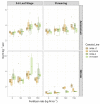Nitrogen Use Efficiency in Parent vs. Hybrid Canola under Varying Nitrogen Availabilities
- PMID: 34834725
- PMCID: PMC8623409
- DOI: 10.3390/plants10112364
Nitrogen Use Efficiency in Parent vs. Hybrid Canola under Varying Nitrogen Availabilities
Abstract
Improving nitrogen use efficiency (NUE) is essential for sustainable agriculture, especially in high-N-demanding crops such as canola (Brassica napus). While advancements in above-ground agronomic practices have improved NUE, research on soil and below-ground processes are limited. Plant NUE-and its components, N uptake efficiency (NUpE), and N utilization efficiency (NUtE)-can be further improved by exploring crop variety and soil N cycling. Canola parental genotypes (NAM-0 and NAM-17) and hybrids (H151857 and H151816) were grown on a dark brown chernozem in Saskatchewan, Canada. Soil and plant samples were collected at the 5-6 leaf stage and flowering, and seeds were collected at harvest maturity. Soil N cycling varied with phenotypic stage, with higher potential ammonium oxidation rates at the 5-6 leaf stage and higher urease activity at flowering. Seed N uptake was higher under higher urea-N rates, while the converse was true for NUE metrics. Hybrids had higher yield, seed N uptake, NUtE, and NUE, with higher NUE potentially owing to higher NUtE at flowering, which led to higher yield and seed N allocation. Soil N cycling and soil N concentrations correlated for improved canola NUE, revealing below-ground breeding targets. Future studies should consider multiple root characteristics, including rhizosphere microbial N cycling, root exudates, and root system architecture, to determine the below-ground dynamics of plant NUE.
Keywords: N availability; N mineralization; canola; fertilizer rates; nitrogen use efficiency; phenological stage; potential ammonium oxidation rates.
Conflict of interest statement
The authors declare no conflict of interest.
Figures







Similar articles
-
Nitrogen Uptake Efficiency, Mediated by Fine Root Growth, Early Determines Temporal and Genotypic Variations in Nitrogen Use Efficiency of Winter Oilseed Rape.Front Plant Sci. 2021 May 13;12:641459. doi: 10.3389/fpls.2021.641459. eCollection 2021. Front Plant Sci. 2021. PMID: 34054891 Free PMC article.
-
Nitrogen Use Efficiency in Durum Wheat Under Different Nitrogen and Water Regimes in the Mediterranean Basin.Front Plant Sci. 2021 Feb 10;11:607226. doi: 10.3389/fpls.2020.607226. eCollection 2020. Front Plant Sci. 2021. PMID: 33643329 Free PMC article.
-
Nitrogen utilisation-efficient oilseed rape (Brassica napus) genotypes exhibit stronger growth attributes from flowering stage onwards.Funct Plant Biol. 2021 Jul;48(8):755-765. doi: 10.1071/FP20263. Funct Plant Biol. 2021. PMID: 33715767
-
The Genetics of Nitrogen Use Efficiency in Crop Plants.Annu Rev Genet. 2015;49:269-89. doi: 10.1146/annurev-genet-112414-055037. Epub 2015 Sep 29. Annu Rev Genet. 2015. PMID: 26421509 Review.
-
Nitrogen use efficiency in crops: lessons from Arabidopsis and rice.J Exp Bot. 2017 May 1;68(10):2477-2488. doi: 10.1093/jxb/erx101. J Exp Bot. 2017. PMID: 28419301 Review.
Cited by
-
Genetic dissection of plant architecture reveals haplotypes controlling sink-related traits in oilseed rape under limited nitrogen fertilization.BMC Plant Biol. 2025 Aug 27;25(1):1138. doi: 10.1186/s12870-025-07035-2. BMC Plant Biol. 2025. PMID: 40859129 Free PMC article.
-
From Soil Amendments to Controlling Autophagy: Supporting Plant Metabolism under Conditions of Water Shortage and Salinity.Plants (Basel). 2022 Jun 22;11(13):1654. doi: 10.3390/plants11131654. Plants (Basel). 2022. PMID: 35807605 Free PMC article. Review.
-
Recent trends in nitrogen cycle and eco-efficient nitrogen management strategies in aerobic rice system.Front Plant Sci. 2022 Aug 25;13:960641. doi: 10.3389/fpls.2022.960641. eCollection 2022. Front Plant Sci. 2022. PMID: 36092421 Free PMC article. Review.
-
Genome-Wide Identification and Characterization of Ammonium Transporter (AMT) Genes in Rapeseed (Brassica napus L.).Genes (Basel). 2023 Mar 6;14(3):658. doi: 10.3390/genes14030658. Genes (Basel). 2023. PMID: 36980930 Free PMC article.
-
Screening Cover Crops for Utilization in Irrigated Vineyards: A Greenhouse Study on Species' Nitrogen Uptake and Carbon Sequestration Potential.Plants (Basel). 2024 Jul 17;13(14):1959. doi: 10.3390/plants13141959. Plants (Basel). 2024. PMID: 39065486 Free PMC article.
References
-
- Statistics Canada Estimated Areas, Yield, Production, Average Farm Price and Total Farm Value of Principal Field Crops, in Metric and Imperial Units. 2020. [(accessed on 30 August 2021)]. Available online: https://www150.statcan.gc.ca/t1/tbl1/en/tv.action?pid=3210035901.
-
- Grant C.A., Bailey L.D. Fertility Management in Canola Production. Can. J. Plant Sci. 1993;73:651–670. doi: 10.4141/cjps93-087. - DOI
-
- Hocking P.J., Stapper M. Effects of Sowing Time and Nitrogen Fertiliser on Canola and Wheat, and Nitrogen Fertiliser on Indian Mustard. I. Dry Matter Production, Grain Yield, and Yield Components. Aust. J. Agric. Res. 2001;52:623–634. doi: 10.1071/AR00113. - DOI
-
- Jackson G.D. Effects of Nitrogen and Sulfur on Canola Yield and Nutrient Uptake. Agron. J. 2000;92:644–649. doi: 10.2134/agronj2000.924644x. - DOI
-
- Rathke G.-W., Christen O., Diepenbrock W. Effects of Nitrogen Source and Rate on Productivity and Quality of Winter Oilseed Rape (Brassica napus L.) Grown in Different Crop Rotations. Field Crop. Res. 2005;94:103–113. doi: 10.1016/j.fcr.2004.11.010. - DOI
Grants and funding
LinkOut - more resources
Full Text Sources

